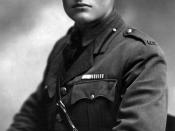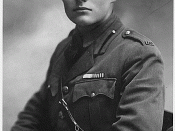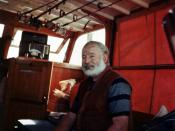The difficulty of life and the human condition is often a theme that surfaces in the works of Ernest Hemingway and while his subject matter is worthy of discussion, it is perhaps his style that has brought him the most popularity. His sparse style and direct approach make him stand out as one of the most celebrated authors of the Twentieth century and his approach to writing is concise and so compelling that it has influenced literature in all genres. Hemingway's style brings life to many of his characters, while at the same time capturing the mood and sentiments of the times. The usage of repetition and ambiguous words in the work of Ernest Hemingway is a well-known characteristic of his writing style. This research essay will consider some of the subjects in Ernest HemingwayÃÂs short stories and novels and the important influence of his writing style.
Hemingway began his writing career as a reporter on the Kansas City Star newspaper.
Hemingway was known for having the logic of a reporter, to observe, not judge. The style notes for reporters opened with these words: ÃÂUse simple, declarative sentences. Avoid adjectivesÃÂ (Star Style Sheet). As one scholar and Hemingway biographer said ÃÂAfter Hemingway, the American sentence became lean, spare, boiled down to its core. The whole sentence is a verb: declarative, unadorned, and Anglo-SaxonÃÂ (Gerard, 6). Although Hemingway continued to write novels and stories throughout his career, the early short stories are often considered to be among his best works. ''Hills like White Elephants,'' a widely anthologized and much discussed story, shows the spare prose and understated dialogue that represents Hemingway's unique style. The story is told nearly in its entirety through dialogue but the most notable feature of the short story "Hills like White Elephants" is that it was told with such strong symbolism. The story is that of a girl and an American man on their trip across Spain to a place where she can have an abortion. Almost everything in the short story is related to the idea of barrenness. These main symbolisms are from the title "Hills like White ElephantsÃÂ where the hills allude to the shape of a pregnant woman and white elephants is an idiom that refers to useless or unwanted gift. It is not a story in the traditional sense with an introduction, a development of the story, and an end, but just gives some time in the life of two people, as if it were just a piece of a film. This story gives little to the reader, only allowing one to see the surface of what is transpiring. Gerard further observed that ÃÂPeople in HemingwayÃÂs stories talk elliptically, leaving out most of whatÃÂs on their minds. The crucial truths lie between the linesÃÂ (Gerard, 8-9). ÃÂHills like White ElephantsÃÂ shows precisely what Gerard was referring to. Hemingway repeats words such as ÃÂandÃÂ seemingly without priority but. The language of the story is what illustrates how fiercely the coupleÃÂs struggle rages beneath their seemingly innocuous and deceptively content-less words Through HemingwayÃÂs use of repetition and role, the elusiveness of his pronouns actually increase the stakes of the argument taking place because their ambiguity can encompass virtually everything or nothing at all. Also, he puts serious thought into how he references his character Jig as ÃÂthe girl.ÃÂ According to author Nadine Devost, Hemingway reveals the nature of his characterÃÂs lives and relationships in various ways in all his stories and one of the most subtle and consistent means by which he does this is by naming and renaming his characters, specifically the females who are often central to the stories. He frequently used the noun ÃÂgirlÃÂ to refer to a female character whose sexual identity is not acknowledged by another character. Thus, Hemingway becomes a word by word writer. Every word no matter how ordinary it may seem carries new poetic importance. The importance of ÃÂa wifeÃÂ suddenly being referred to as ÃÂa girlÃÂ is so subtle but so meaningful (Devost, 7-8). Devost further proves this point by examining a few of HemingwayÃÂs drafts where he commented and edited these phrases or nouns several times very meticulously (Devost, 3). An additional manifestation of this technique is in HemingwayÃÂs female character in "Cat in the Rain," a story chronicling a womanÃÂs realization of her loneliness within her marriage and her discovery and expression of its causes. At the beginning of the story, the woman is referred to as "the American wife," to emphasize that she is married. The moment she finds her cat has gone missing she is referred to as "the American girl", indicating that through this loss she has suffered a decline in self as well. Still, never once are we given her name as clearly this woman has no mature sexual identity of her own. What she does have is associated to her husbandÃÂs. This is shown with use of the possessive pronoun "his" and in the repetitions of "his wife" (Hemingway, 407-9). The characters that populate HemingwayÃÂs fiction display, these references are never irrelevant but are instrumental in conveying the predicaments in which these women find themselves. From his youth at the Kansas City Star through his service in World War I, Ernest Hemingway developed a style that made him a highly revered author. His techniques and style have influenced scores of writers the world over.
This style of HemingwayÃÂs led to the creation of a character that has become known as the Code Hero. These heroes will risk their lives for a principle and to live up their code, but will never sacrifice their honor. This code hero could be a person that the hero tried to be like, or the code hero might be a principle or idea that the hero tried to uphold. The hero grew out of Hemingway's belief that the trials a man endures help shape his character. Hemingway's bold writing style made possible creating and describing the characters in his works. Hemingway believed that the overdone prose of the previous age was in some way untrue, and that abstract words such as glory, honor, and courage were hollow or even appalling. John Pidgeon determined that to follow this code ÃÂOne must show no emotions and form no emotional attachments. One must face life realistically without resorting to abstractions or to complex thought. This stance, this code; is clearly defensiveÃÂ (Pidgeon, 2). So in Hemingway, sentimentality is turned inwards, not restrained just hidden below the surface. He clearly gives his readers a feel of the presence of emotions although they are for the most part not visible in his actual words. According to scholar Hallengren, Hemingway instead, to convey their underlying presence, Hemingway used truth, guilelessness, facts, and events to produce equally strong reactions in his readers (Hallengren, 2). This scholar asserts that ÃÂHemingwayÃÂs insensitive detachment is only superficial, a compulsive avoidance of the emotional, but not the emotionally tinged or chargedÃÂ (Hallengren, 4). Hemingway is known to focus his novels around code heroes who struggle with the mixture of their tragic faults and the surrounding environment. The Code Hero always exhibits some form of a physical wound that serves as his tragic flaw and the weakness of his character. Traits of a typical Hemingway Code Hero are a liking of stimulating surroundings, strict moral rules, including honesty and loyalty, indulgence but not over indulgence, and stoicism. It is interesting and worth noting that Hemingway never goes inside his heroes, but describes them always from the outside with his infamous straightforward dialogue and simple descriptions. Hemingway accomplished, in his unique style, the creation of a complex hero that is interminably and mysteriously exhibits grace under pressure at all times.
HemingwayÃÂs essential existential message was always that man is a helpless victim of a cruel world. To Hemingway, life inflicts such violence and pain that it wounds every man unreasonably. Gerard notices that in his works ÃÂThereÃÂs a fascination with death, violence, survival and something else: a code of conduct, a muting of emotions, understatement as an expression of graceÃÂ (Gerard, 8). Existentialism is a major component of Hemingway's fiction. There is focus on the strength and perseverance of the individual, the belief that man create himself, and that there is existence before essence. It's the responsibility of Hemingway's characters to create their essence, to make their choices, and to realize that if the world is meaningless. Author John Pidgeon asserts that to Hemingway as an existentialist, love is dangerous since to love is to become vulnerable to fate and thus risking the loss of such a profound connection. To Hemingway loss was inevitable, as something always brought on the end. Love expires through death or disenchantment, fame always dwindles, and youth and vitality disintegrate as time passes. Even though he held these reservations especially toward the idea of love he still held it to be the ultimate aspect of existence. Hemingway once said ÃÂLove enlarges the scope of the mind, enhances the mental faculties, and gives poise to enthusiasmÃÂ (Wagner, 22). The world as Hemingway saw it and as he wrote it for his characters was bleak and incoherent. This existential view of the universe lacks order and meaning and is illogical and even antagonistic. For Hemingway, man is born into a completely indifferent universe, a universe without supernatural jurisdiction, and thus without purpose. There is then ÃÂnadaÃÂ, or ÃÂnothingÃÂ at the core of the universe. Existentialism focuses on manÃÂs confrontation with the absence of God, the indifference and seeming hostility of the universe, and thus with the absence of meaning, and value in human life. Even so, there may be ÃÂnadaÃÂ at the center of the universe, but there is something very substantial at the center of HemingwayÃÂs heroes.
Ernest Hemingway was a larger than life figure, an American icon that represented masculinity at its highest form. He was a hunter, fisherman, and connoisseur of bullfights and boxing. He seemed to be the epitome of a man's man who dared others to seek adventure. He could be shy and diffident as well as an incorrigible braggart. He was insanely proud of his own celebrity and yet still envious and capable of making venomous remarks about other writers. He could be a stoic and fearless warrior, and then be sensitive and quick to tears. He was a generous friend and a ruthless enemy. Ernest Hemingway was a man of action sharing a body with a man of words. These contrasts made Hemingway the distinctive writer he came to be, from his earliest stories to his last published novel, the same illustrious themes and motifs recur time and again, are dealt with by his mysterious code heroes, and articulated in his sparse signature style continue to intrigue readers and writers the world over.
Works CitedBaker, Carlos. Hemingway: The Writer as Artist. Fourth edition, Princeton University Press:Princeton, NJ, 1972.
Buske, Morris. "Hemingway faces God.(Ernest Hemingway)(Biography)." The HemingwayReview 22.1 (Fall 2002): 72(16). Expanded Academic ASAP. Thomson Gale. San Antonio College. 1 Apr. 2007.
Charters, Samuel and Ann. "Hills Like White Elephants." Literature and its Writers. Gen. ed.
Karen S. Henry. Boston: Bedford St. Martin, 2004. 229-233.
Devost, Nadine. "Hemingway's girls: Hemingway's female characters." Hemingway Review14.1 (1994): 46. MasterFILE Premier. 1 April 2007. http://hermes.sac.accd.edu:2053Durham, Philip. ÃÂErnest HemingwayÃÂs Grace Under Pressure: The Western Code.ÃÂ The PacificHistorical Review, Vol. 45, No. 3. (Aug., 1976), pp. 425-432.
http://links.jstor.org/sici?sici=0030-Evans, Robert. "Hemingway and the Pale Cast of Thought." American Literature 38.2 (1966):161. Academic Search Premier. 1 April 2007. http://hermes.sac.accd.edu:2053Gerard, Philip. "Facing Eternity Alone : Ernest Hemingway, man and writer, is a study incontradictions." World and I 14.11 (Nov 1999): 254. Expanded Academic ASAP. Thomson Gale. San Antonio College. 1 Apr. 2007
Hallengren, Anders. "A Case of Identity: Ernest Hemingway." 28 August 2001: 1-6.16February 2007. http://www.Nobelprize.org.
Hemingway, Ernest. ÃÂCat in the Rain.ÃÂ The Practical Guide to Writing with Readings andHandbook. 8th ed. Eds. Sylvan Barnet, Marcia Stubbs, Pat Bellanca. New York: Longman, 2000. 407-10.
Hemingway, Ernest. "A Moveable Feast: Sketches of the AuthorÃÂs Life in Paris in theTwenties." (1993). MagillOnLiterature Plus. 2 April 2007.
http://hermes.sac.accd.edu:2053Kansas City Star Copy Style Sheet. (Online) Availablehttp://www.lostgeneration.com/includes/Hemingwaystylesheet.pdf 22 March 2007.
Kehoe, John. "Ernest Hemingway." Biography 6.3 (2002): 108. Academic Search Premier. 1April 2007. http://hermes.sac.accd.edu:2053Link, Alex. "Staking everything on it: a stylistic analysis of linguistic patterns in "Hills LikeWhite Elephants".(Critical Essay)." The Hemingway Review 23.2 (Spring 2004): 66(10). Expanded Academic ASAP. Thomson Gale. San Antonio College. 1 Apr. 2007.
Pidgeon, John A. "Ernest Hemingway." Modern Age 48.1 (Wntr 2006): 90(3). ExpandedAcademic ASAP. Thomson Gale. San Antonio College. 1 Apr. 2007.
The Complete Short Stories. The Finca VigÃÂa ed. Charles Scribner's Sons: New York, 1998.
Vernon, Alex. "War, gender, and Ernest Hemingway.(Critical Essay)." The HemingwayReview 22.1 (Fall 2002): 34(22). Expanded Academic ASAP. Thomson Gale. San Antonio College. 1 Apr. 2007.
Wagner-Martin, Linda (Ed.). A Historical Guide to Ernest Hemingway. Oxford UniversityPress: New York and Oxford, 2000.


